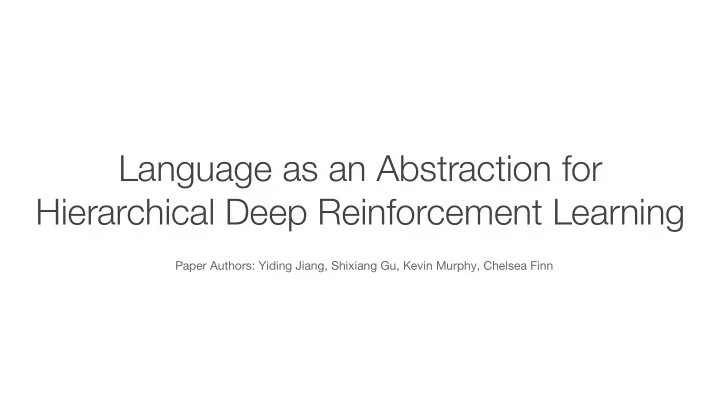

Language as an Abstraction for Hierarchical Deep Reinforcement Learning Paper Authors: Yiding Jiang, Shixiang Gu, Kevin Murphy, Chelsea Finn
Problem Overview Learning a variety of compositional , long horizon skills while being able to ● generalize to novel concepts remains an open challenge. Can we leverage the compositional and generalizable structure of language ● as an abstraction for goals to help decompose problems?
Learning Sub-Goals Hierarchical Reinforcement Learning: - High-level policy: π h (g | s) - Low-level policy: π l (a | s, g)
Language as an abstraction for goals Hierarchical Reinforcement Learning: - High-level policy: π h (g | s) - Low-level policy: π l (a | s, g) What if g is an sentence in human language? Some motivations in paper: 1) High-level policies would generate interpretable goals 2) An instruction can represent a region of states that satisfy some abstract criteria 3) Sentences have a compositional and generalizable structure 4) Humans use language as an abstraction for reasoning, planning, and knowledge acquisition
Concrete Examples Studied High Level: Low level:
Environment ● New environment using MuJoCo physics engine and CLEVR language engine. ● Binary reward function, only if all the constraints are met ● State-based observation: ● Image-based observation:
Methods
Low-Level Policy Language to state mapping Checking if a state satisfies an instruction Trained on sampled language instructions
Low-Level Policy Reward Function
Low-Level Policy Reward Function Can be very sparse Hindsight Instruction Relabeling (HIR) Similar to Hindsight Experience Replay (HER) ● HIR is used to relabel the goal with an instruction that ● was satisfied. Enable the agent to learn from many different language ● goals at once
High-Level Policy ● Double Q-Learning Network [1] ● Reward given only if all constraints were satisfied from the environment ● Instructions (goals) are pick, not generated. ● Uses extracted visual features from the low-level policy and then extract salient spatial points with spatial softmax. [2] [1] [2]
Experiments
Experimentation Goals Compositionality: How does language compare with alternative ● representations? Scalability: How well does this framework scale? ● With instruction diversity ○ With state dimensionality ○ Policy Generalization: Can the policy systematically generalize by leveraging ● the structure of language? Overall, how does this approach compare to state-of-the-art hierarchical RL ● approaches?
Experimentation Goals Compositionality: How does language compare to alternative representations? ● Scalability: How well does this framework scale? ● With instruction diversity ○ With state dimensionality ○ Policy Generalization: Can the policy systematically generalize by leveraging ● the structure of language? Overall, how does this approach compare to state-of-the-art hierarchical RL ● approaches?
Compositionality: How does language compare to alternative representations? One-hot instruction encoding ● Non-compositional Representation: loss-less autoencoder for instructions. ●
Experimentation Goals Compositionality: How does language compare with alternative ● representations? Scalability: How well does this framework scale? ● With instruction diversity ○ With state dimensionality ○ Policy Generalization: Can the policy systematically generalize by leveraging ● the structure of language? Overall, how does this approach compare to state-of-the-art hierarchical RL ● approaches?
Scalability: How well does this framework scale? With instruction diversity ● With state dimensionality ●
Experimentation Goals Compositionality: How does language compare with alternative ● representations? Scalability: How well does this framework scale? ● With instruction diversity ○ With state dimensionality ○ Policy Generalization: Can the policy systematically generalize by leveraging ● the structure of language? Overall, how does this approach compare to state-of-the-art hierarchical RL ● approaches?
Policy Generalization: Can the policy systematically generalize by leveraging the structure of language? Random: 70/30 random split of the instruction set. Systematic: Training set doesn’t include “red” in the first half of instructions, and Test set is the complement. => Zero-shot Adaptation
Experimentation Goals Compositionality: How does language compare with alternative ● representations? Scalability: How well does this framework scale? ● With instruction diversity ○ With state dimensionality ○ Policy Generalization: Can the policy systematically generalize by leveraging ● the structure of language? Overall, how does this approach compare to state-of-the-art hierarchical RL ● approaches?
High-Level Policy Experiments DDQN: non-hierarchical HIRO and OC: hierarchical, non-language based
High Level Policy Experiments (Visual)
Takeaways ● Strengths: ○ High-level policies are human-interpretable ○ Low-level policy can be re-used for different high-level objectives ○ Language abstractions generalized over a region of goal states, instead just an individual goal state ○ Generalization to high dimensional instruction sets and action spaces ● Weakness: ○ Low-level policy depends on the performance of another system for its reward ○ HIR is dependent on the performance of another system for its new goal label ○ The instruction set is domain-specific ○ The number of subtasks are fixed
Future Work Instead of picking instructions, generate them ● Dynamic or/and learned number of substeps ● Curriculum learning by decreasing the number of substeps as the policies are training ○ Study how does the parameter effects the overall performance of the model ○ Finetune policies to each other, instead just training them separately ● Concern about practicality: for any problem need both a set of sub-level ● instructions and a language oracle which can validate their fulfilment Other ways to validate low-level reward ●
Potential Discussion Questions Is it prideful to try to use language to try to impose language structure on ● these subgoals instead of looking for less human-motivated solutions? In two equally performing models, one with language interpretability seems ● inherently better due to interpretability. Does this make these types of abstractions likely for the future? Can you think of any other situations in which this hierarchical model could ● be implemented? Would language always be appropriate?
Appendix
Overall Approach: Object Ordering
Overall Approach: Object Ordering
Overall Approach: Object Ordering
Overall Approach: Object Ordering
Overall Approach: Object Ordering
State-based Low-Level Policy
Vision-based Low-Level Policy
Recommend
More recommend